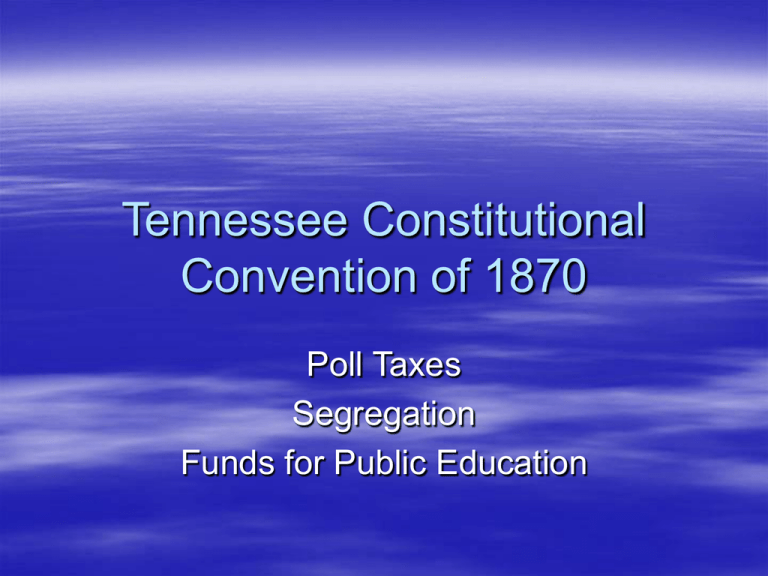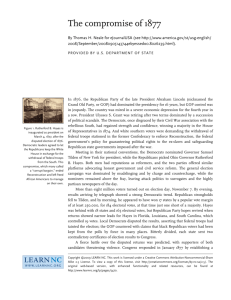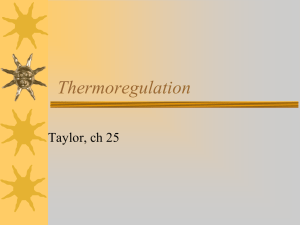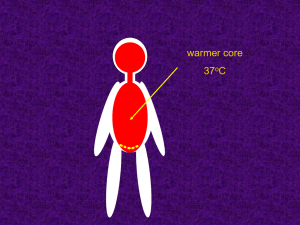Yellow Fever in Middle Tennessee
advertisement

Tennessee Constitutional Convention of 1870 Poll Taxes Segregation Funds for Public Education What does the Tennessee Constitution of 1870 say about…. poll taxes: enacted to prevent African Americans from voting; evidence that poll taxes paid was required segregation: legal segregation of the races through Jim Crow laws (buses, restaurants, public libraries, public parks, waiting rooms, bathrooms, telephone booths, drinking fountains, and schools funds for public education – against the law to integrate schools so funds went to white schools primarily with only minimal funds given to black schools Election of Rutherford B Hayes Compromise of 1877 Election of 1876: Republican Rutherford Hayes v. Democrat Samuel Tilden Tilden had a reputation as a reformer Southerners (whites) would definitely vote for the Democrat but 3 southern states – LA, FL, SC – returned duplicate sets of electoral returns. One set of returns gave all the votes to Tilden and one gave them all to Hayes. Tilden was short ONE vote to win the Presidency so all he needed from the disputed returns was ONE electoral vote. Congress resolved by appointing an Electoral Commission to investigate the duplicate returns and to settle whom the votes belonged to. 15-member commission – 7 Republicans, 7 Democrats, and 1 Independent (who would break tie votes). Right before vote of the Commission, the Independent was offered a Supreme Court seat by President Grant (Republican) and he accepted. A Republican was selected to replace the Independent, giving the Republicans 8 votes on the Commission to the Democrats 7. The vote went 8 to 7 to give ALL the contested electoral votes to Hayes and he got the Presidency. Why would the Democrats allow the Presidency to be stolen from them? Knowing that the party vote of 8 – 7 would be divisive to the nation, the Republicans back-roomed a deal with the Democrats to remove the last of the federal troops from southern states and end military Reconstruction. The Democrats took the deal – Reconstruction ended, Tilden lost the Presidency, and Hayes served one long unpopular term often called “His Fraudulency” or “Old 8 to 7” in derision. Yellow Fever in Middle Tennessee What is yellow fever? What was the impact of yellow fever during the 1870s? Why was it particularly deadly in West Tennessee? For residents of West Tennessee, and particularly Memphis, yellow fever posed the greatest threat. The disease caused fevers, chills, hemorrhaging, severe pains, and sometimes a jaundicing of the skin, which gave yellow fever its name. The trademark of the disease, however, was the victim's black vomit, composed of blood and stomach acids. Although its cause was unknown until 1900, yellow fever was transmitted from person to person by female mosquitoes. Sailors on ships from the Caribbean or West Africa, from which the disease most likely originated, docked in New Orleans, where mosquitoes spread the disease from the infected person to the local population. River traffic carried yellow fever up the Mississippi Valley as long as mosquitoes were available to transmit the disease from human to human. Reprieve came only with the first frost. 1873: 2,000 in Memphis, the most yellow fever victims in an inland city. 1878: mild winter, long spring, torrid summer produced favorable conditions for breeding of mosquitoes and spread the fever. By August 13 the first death was reported in the city itself. roughly 25,000 residents fled the city within two weeks. fever raged in Memphis until mid-October, infecting over 17,000 and killing 5,150. Over 90 percent of whites who remained contracted yellow fever, and roughly 70 percent of these died. Long thought to be immune to the disease, blacks contracted the fever in large numbers as well in 1878, although only 7 percent of infected blacks died. African Americans Elected to General Assembly Despite poll tax and KKK intimidation, African-American legislators were elected in the 1870s. Through much of the 1880s, there were four African-Americans in the Tennessee House. Voting laws were changed in the late 1800s which made it impossible for blacks to be elected to public office SAMPSON W. KEEBLE . . . . . . Davidson County . . . . . . . 1873-1874 JOHN W. BOYD . . . . . . . . . . . . .Tipton County . . . . . . . . . . 1881-1884 (2 terms) THOMAS F. CASSELS . . . . . . . Shelby County . . . . . . . . . .1881-1882 ISAAC F. NORRIS . . . . . . . . . . .Shelby County . . . . . . . . . 1881-1882 THOMAS A. SYKES . . . . . . . . . Davidson County . . . . . . .1881-1882 LEON HOWARD . . . . . . . . . . . . Shelby County . . . . . . . . . 1883-1884 SAMUEL A. McELWEE . . . . . . Haywood County . . . . . . .1883-1888 * (3 terms) DAVID F. RIVERS . . . . . . . . . . Fayette County . . . . . . . . . . 1883-1884 * GREENE E. EVANS . . . . . . . . . Shelby County . . . . . . . . . 1885-1886 WILLIAM FEILDS . . . . . . . . . . . .Shelby County . . . . . . . . .1885-1886 WILLIAM C. HODGE . . . . . . . . Hamilton County . . . . . . .1885-1886 MONROE W. GOODEN . . . . . . Fayette County . . . . . . . . .1887-1888 STYLES L. HUTCHINS . . . . . . .Hamilton County . . . . . . . .1887-1888 JESSE M. H. GRAHAM . . . . . . .Montgomery County . . . .1897 (unseated) *Both Rivers and McElwee were prevented by white supremacists from serving a later term to which they had been elected. No other African Americans served in the TN General Assembly until 1965











